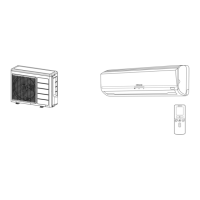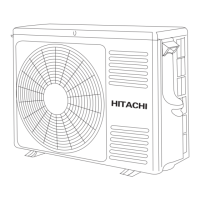– 63 –
2. Indoor/Outdoor Interface Circuit
● The interface circuit superimposes an interface signal on the DC 35V line supplied from the outdoor unit
to perform communications between indoor and outdoor units. This circuit consists of a transmiting circuit
which superimposes an interface signal transmit from the microcomputer on the DC 35V line and a
transmiting circuit which detects the interface signal on the DC 35V line and outputs it to the microcomputer.
● Communications are performed by mutually transmiting and receiving the 4-frame outdoor request signal
one frame of which consists of a leader of approx. 100 ms., start bit, 8-bit data and stop bit and the
command signal with the same format transmit from the indoor unit.
● From outdoor microcomputer to indoor microcomputer.
The request signal output from microcomputer pin 73 , 74 , 9 is input to the transmitting circuit. The
transmitting circuit modulates this signal by approx. 38kHz high-frequency. This high-frequency signal is
amplified by a transistor, superimposed on the DC 35V line via C801 (or C811, C821) and L801 (or L802,
L803), and supplied to the indoor unit.
To prevent erroneous reception, the outdoor microcomputer is designed so that it cannot receive a signal
while is is outputting a request signal.
The receiving circuit in the indoor unit consists of a comparator and transistor. The interface signal from
the outdoor unit on the DC 35V line is supplied to C821, where DC components are eliminated, and is
then shaped by the comparator. The shaped signal is detected by diode, amplified by amp, and supplied
to receiving input of the indoor microcomputer.
Fig. 2-2 shows the voltages at each component when data is transferred from the outdoor microcomputer
to the indoor microcomputer.
● Indoor microcomputer to outdoor microcomputer.
The communications from the indoor microcomputer to the outdoor micro computer are the same.
Fig. 2-3 shows the voltages and waveforms at each circuit.

